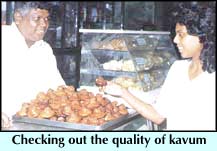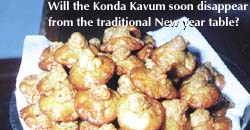 |
 11th April 1999 |
Front Page| |
Will the Konda Kavum soon disappear from the traditional New Year table?Dying delicacyBy Chamintha ThilakarathnaNo New Year dining table would be complete without the 'konda kavum',- a symbol of the New Year and of the seasonal festivity. But how much longer would the 'konda kavum' survive if not for the sweetmeat parlours? Sadly the preparation of this once familiar household delicacy is today a dying art.
Although they have 25 employees to make the sweet, the demand is rising due to the scarcity of kavum makers. People who used to be paid Rs.50 a day are now demanding a minimum of Rs.225, Mr. Priyanka says. "We have no choice but to pay them, because quality is a key word in this trade and it is difficult to replace these kavum experts," he said. Last year, the Kirulapone branch of Sweet House alone had sold over 125,000 pieces of kavum during the Sinhala and Tamil New Year. In all their three branches they estimated sales of around four lakhs of kavum during this period. "But we have never managed to supply enough to meet the full demand due to the lack of professional kavum makers. "We have around 25 employees in this department but that's not adequate although they are capable of making hundreds of pieces a day," Mr. Priyanka lamented. The situation was not much different at the Sumanadisi Bakery at Wellawatta.
According to him, they have tested a number of samples but have not been satisfied with many. Even as The Sunday Times entered, another supplier for the branch was on her way out. "Quality is important. We don't accept the kavums made on the mould (achchuwa)," he said. Many sweetmeat store officials based in the city complained that so far they have never met the demand. "Every year we run out of stocks and are compelled to turn down most of the last-minute buyers," they said. Last week, housewives were seen placing early orders to ensure that their new year table was not short of 'konda kavum'. "We can do without the konda kavum but then it does not seem complete. Since they are quite expensive, we try to purchase at least a few just to decorate the table," said a housewife from Moratuwa. But is the younger generation taking little or no interest in traditional cooking methods and items? K.D. Milinona, a 65-year-old kavum supplier who has been making them ever since she was a child said there is a need for the younger generation to take to the art of making kavum. "I have been making kavum for at least 30 years and during that period I have tried to train others but very few people seem to be taking an interest," she said. Comparing the times when she was a child, she said every housewife of her era knew how to make the sweetmeat. In contrast, now, except in the rural areas, few people seem to make the delicacy at home. Milinona's reasoning was that people have come to depend on easy lifestyles where they can purchase the sweetmeat from a store instead of making it at home. She also feels that the New Year tables of today mostly have foods like cakes, biscuits and other non-traditional sweets. "What people don't realise is that it is not a question of whether the kavum is on your festival dining table or not. The preparation of traditional assortments creates a festive spirit and the togetherness of the community. In the early days communities got together to make the sweetmeats," she said. But housewives argued that the modern lifestyle put many restrictions on them. Lack of time due to household chores and careers, leaves them no choice but to resort to ready-made products. Of course, kavum is not the easiest to prepare. Not only is it time consuming but also quite tricky. The texture, the exact amounts of flour, honey, sugar and other ingredients to be mixed, and even the formation of the 'konda' part of the kavum all depends on the experience and skill of a person and cannot be mastered overnight. Also, one needs to have adequate knowledge of the ingredients. For example the honey that would be used. But most of this expertise has not been passed on theoretically but practically. "Professional kavum makers do not wish to impart all their secrets of successful kavum-making to students. The secret on how to get the exact taste and texture, is rarely passed onto new comers," said the sweet store owners. "It's all in the experience. Once you start to make the kavum, you will learn the secrets on your own," Milinona said. It takes us only a matter of minutes to eat the kavum. But the labour and care that go into each one are much more than we realise. "If younger generations do not learn how to make the 'konda kavum' it is very likely that our children may never know about this delicacy that poets describe with glory and pride," Milinona says.
|
||
 |
Front Page| News/Comment| Editorial/Opinion| Business| Sports | Mirror Magazine |
|
 |
Please send your comments and suggestions on this web site to |
|
 Managing
Director of the Kirulapone Sweet House branch, Channa Priyanka is among
those concerned. It is difficult to find people competent enough to make
the traditional 'konda kavum', he says.
Managing
Director of the Kirulapone Sweet House branch, Channa Priyanka is among
those concerned. It is difficult to find people competent enough to make
the traditional 'konda kavum', he says. "It
is difficult to find people to make the kavum and they ask high rates,"
said the branch manager.
"It
is difficult to find people to make the kavum and they ask high rates,"
said the branch manager.